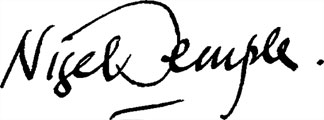Portrait of the Artist
Materials that had already known previous lives were rescued, brought together, worked upon and represented so as to reveal fresh insight and heightened significance
Various media were ‘weathered’ prior to assembly, each collage a fascinating mix of serendipity and planning
Temple was a painter, collagist and maker of small objets trouvé assemblages. The materials he used for his collages and assemblages had been sought out or found by the artist having been previously discarded by others.
Temple’s distinctive use of collage stemmed from a number of interests and ideas he had pursued at art school and in the years that followed.
Whilst studying at Farnham School of Art (1948 – 52) Temple specialised in illustration. This course introduced him to 19th century book production and provided him with a deep understanding and love of the materials and processes involved in making books: paper, cloth, leather, typography, graphic and photographic media and binding. Books were to provide an endless source of material for the collages he began to create in the 1970’s. In Temple’s own words:
“fragments from wrecked books are the most stimulating material. When using them I fell an intimate relationship with even the smallest particles. They have led lives and been discarded as spent, yet they can still speak back and invite rebirth”.
Another key influence was to occur whilst Nigel was researching his dissertation for a teaching diploma at the University of Sheffield (1952-3). The subject was the buildings of Farnham and as he later recalled:
“Walking along the streets of Farnham made me aware of the qualities to be found in vernacular building and the organic nature of traditional landscape. I was alerted to the dangers to which these delicate assemblages were exposed in the post-war years.”
This early perception of the fragility and durability of materials, in this case buildings and the manner in which they change over time, had a direct impact on Nigel’s subsequent use of collage from the 1970’s onwards.
“Materials that had already known previous lives were rescued, bought together, worked upon and represented so as to reveal fresh insight and heightened significance”
Once acquired, badly deteriorated materials were often subjected to further beating, sanding, shredding and tearing before they were considered to be in an ‘acceptable’ state for use. Nigel would then loosely arrange the pieces on a surface or within a frame and begin an elaborate process of:
Adding, subtracting, cutting, scraping and overlapping until the resulting qualities of surface, texture, translucence, colour and shape acquired for him a significance beyond the sum of the individual parts.
Whilst many of his works belong to a series, Nigel maintained that there was never a prior image or subject guiding his hand and eye until the final phase of the creative process. Only then would such possibilities arise. As he described it:
“The practical process is an attempt to capture with these scraps, glimpses of the myriad fleeting images and reminiscences that dart and flicker through my thoughts.”
In the 1970’s works included the series In Memoriam and Sarem, in the 1980s he created the series Night Passage and Goddess, in the 1990s two series, Cody and Portrait of the Artist as an Aeronaut and finally the Toulon Series, some of the last collages he made.
In the Goddess series, the suggestion of the female form evolved as he worked with the materials, while in the Portrait of the Artist as an Aeronaut series, the link between material and image derives from a more definite source: his ambition and failure to fly solo.
As well as his two-dimensional collages, Nigel produced three-dimensional work. His boxed assemblages share many of the same concerns as his collages.
Containing fragments of natural or preformed materials, these constructions are instantly recognisable of the Surrealist assemblages of the 1920s and 1930s. Often enclosed in boxes or within draws, they invite a sense of childlike wonder and curiosity. For Nigel they were attempts to capture past memories or translate particular moments.
Nigel showed a deep respect for the materials he used, and had unique sensitivity to the new visual situations these materials could be given through his fingertips.
Nigel spent five years as a full time art student, then lectured at and headed departments at colleges of art and education until 1978. He then held an artist-in-residence secondment at Bristol University. As a member of the Royal West of England Academy RWA he was an active contributor and exhibitor. He showed also with the Cheltenham Group of Artists and on the continent. He had a series of solo exhibitions of his own work, including at the RWA in Bristol and at Cheltenham Art Gallery 1998, both now hold his work in their Permanent Collections.
Nigel exhibited at the University of Bristol, New Ashgate Gallery in Farnham in 1990 and University of Reading in 1991. The Thelma Hulbert Gallery in Honiton held a fifty year retrospective in 2000 entitled ‘Continuum’. Since his death Nigel’s collages have been exhibited at Anthony Hepworth Fine Art, Bath.
Mark Doyle, Contemporary Art Society

